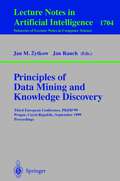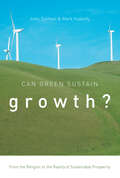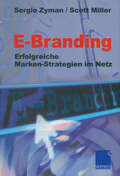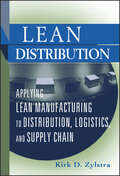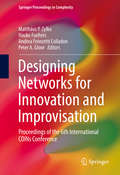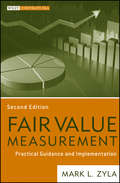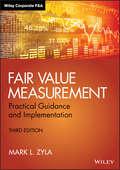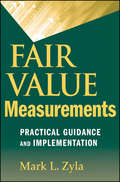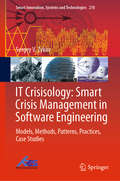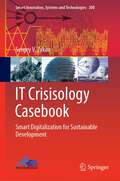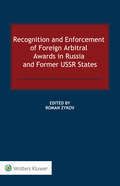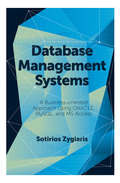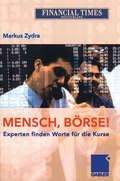- Table View
- List View
Consumer Credit and the American Economy (Financial Management Association Survey and Synthesis)
by Todd J. Zywicki Michael E. Staten Thomas A. Durkin Gregory ElliehausenConsumer Credit and the American Economy examines the economics, behavioral science, sociology, history, institutions, law, and regulation of consumer credit in the United States. After discussing the origins and various kinds of consumer credit available in today's marketplace, this book reviews at some length the long run growth of consumer credit to explore the widely held belief that somehow consumer credit has risen "too fast for too long." It then turns to demand and supply with chapters discussing neoclassical theories of demand, new behavioral economics, and evidence on production costs and why consumer credit might seem expensive compared to some other kinds of credit like government finance. This discussion includes review of the economics of risk management and funding sources, as well discussion of the economic theory of why some people might be limited in their credit search, the phenomenon of credit rationing. This examination includes review of issues of risk management through mathematical methods of borrower screening known as credit scoring and financial market sources of funding for offerings of consumer credit. The book then discusses technological change in credit granting. It examines how modern automated information systems called credit reporting agencies, or more popularly "credit bureaus," reduce the costs of information acquisition and permit greater credit availability at less cost. This discussion is followed by examination of the logical offspring of technology, the ubiquitous credit card that permits consumers access to both payments and credit services worldwide virtually instantly. After a chapter on institutions that have arisen to supply credit to individuals for whom mainstream credit is often unavailable, including "payday loans" and other small dollar sources of loans, discussion turns to legal structure and the regulation of consumer credit. There are separate chapters on the theories behind the two main thrusts of federal regulation to this point, fairness for all and financial disclosure. Following these chapters, there is another on state regulation that has long focused on marketplace access and pricing. Before a final concluding chapter, another chapter focuses on two noncredit marketplace products that are closely related to credit. The first of them, debt protection including credit insurance and other forms of credit protection, is economically a complement. The second product, consumer leasing, is a substitute for credit use in many situations, especially involving acquisition of automobiles. This chapter is followed by a full review of consumer bankruptcy, what happens in the worst of cases when consumers find themselves unable to repay their loans. Because of the importance of consumer credit in consumers' financial affairs, the intended audience includes anyone interested in these issues, not only specialists who spend much of their time focused on them. For this reason, the authors have carefully avoided academic jargon and the mathematics that is the modern language of economics. It also examines the psychological, sociological, historical, and especially legal traditions that go into fully understanding what has led to the demand for consumer credit and to what the markets and institutions that provide these products have become today.
Principles of Data Mining and Knowledge Discovery: Third European Conference, PKDD'99 Prague, Czech Republic, September 15-18, 1999 Proceedings (Lecture Notes in Computer Science #1704)
by Jan Zytkow Jan RauchThis book constitutes the refereed proceedings of the Third European Conference on Principles and Practice of Knowledge Discovery in Databases, PKDD'99, held in Prague, Czech Republic in September 1999.The 28 revised full papers and 48 poster presentations were carefully reviewed and selected from 106 full papers submitted. The papers are organized in topical sections on time series, applications, taxonomies and partitions, logic methods, distributed and multirelational databases, text mining and feature selection, rules and induction, and interesting and unusual issues.
Can Green Sustain Growth?: From the Religion to the Reality of Sustainable Prosperity (Innovation and Technology in the World Economy)
by John Zysman Mark HubertyGreen growth has proven to be politically popular, but economically elusive. Can Green Sustain Growth? asks how we can move from theoretical support to implementation, and argues that this leap will require radical experimentation. But systemic change is costly, and a sweeping shift cannot be accomplished without political support, not to mention large-scale cooperation between business and government. Insightful and timely, this book brings together eight original, international case studies to consider what we can learn from the implementation of green growth strategies to date. This analysis reveals that coalitions for green experimentation emerge and survive when they link climate solutions to specific problems with near-term benefits that appeal to both environmental and industrial interests. Based on these findings, the volume delivers concrete policy recommendations for the next steps in the necessary shift toward sustainable prosperity.
E-Branding: Erfolgreiche Markenstrategien im Netz
by Sergio Zyman Scott MillerNeue Technologie benötigt kein neues Marketing. Auch online bedarf es stringenter Methode und Disziplin, um das Branding zu vertiefen. Am Ende des Massen-Marketing geben der bekannte Marketing-Guru und sein Co-Autor wertvolle Anregungen für die individuelle Kundenbindung. Ein Leitfaden für alle, die ihren Geschäftserfolg online nachhaltig verbessern wollen.
Lean Distribution: Applying Lean Manufacturing to Distribution, Logistics, and Supply Chain
by Kirk D. Zylstra"Kirk Zylstra's focus on the customer is a fresh approach to lean. Companies that can bear the burden of variability will develop a strategic advantage in today's volatile market." —Travis Jarrell Institute of Industrial Engineers Program Committee Chair "Lean Distribution is a comprehensive yet concise work with clear leanings. Kirk's experience across a range of industries brings a unique understanding of common opportunities and solutions available to optimize distribution processes. Lean techniques, typically effective in manufacturing processes, are applied in the downstream supply chain in a practical and productive manner that will offer something to any business distributing tangible goods." —F. Jeff Duncan Jr. VP, CIO, and Director of Technology Louisiana Pacific Corp. "Lean Distribution has robustly captured the revolution occurring in today's increasingly competitive and global supply chain. Eliminating losses through lean manufacturing and lean distribution initiatives will become even more critical enablers to organizations developing cost-advantaged supply chains." —Rick McDonald Director of Manufacturing The Clorox Company
Lean Distribution: Applying Lean Manufacturing to Distribution, Logistics, and Supply Chain
by Kirk D. Zylstra"Kirk Zylstra's focus on the customer is a fresh approach to lean. Companies that can bear the burden of variability will develop a strategic advantage in today's volatile market." —Travis Jarrell Institute of Industrial Engineers Program Committee Chair "Lean Distribution is a comprehensive yet concise work with clear leanings. Kirk's experience across a range of industries brings a unique understanding of common opportunities and solutions available to optimize distribution processes. Lean techniques, typically effective in manufacturing processes, are applied in the downstream supply chain in a practical and productive manner that will offer something to any business distributing tangible goods." —F. Jeff Duncan Jr. VP, CIO, and Director of Technology Louisiana Pacific Corp. "Lean Distribution has robustly captured the revolution occurring in today's increasingly competitive and global supply chain. Eliminating losses through lean manufacturing and lean distribution initiatives will become even more critical enablers to organizations developing cost-advantaged supply chains." —Rick McDonald Director of Manufacturing The Clorox Company
Designing Networks for Innovation and Improvisation: Proceedings of the 6th International COINs Conference (Springer Proceedings in Complexity)
by Matthäus P. Zylka Hauke Fuehres Andrea Fronzetti Colladon Peter A. GloorThis volume is focused on the emerging concept of Collaborative Innovation Networks (COINs). COINs are at the core of collaborative knowledge networks, distributed communities taking advantage of the wide connectivity and the support of communication technologies, spanning beyond the organizational perimeter of companies on a global scale. It includes the refereed conference papers from the 6th International Conference on COINs, June 8-11, 2016, in Rome, Italy. It includes papers for both application areas of COINs, (1) optimizing organizational creativity and performance, and (2) discovering and predicting new trends by identifying COINs on the Web through online social media analysis. Papers at COINs16 combine a wide range of interdisciplinary fields such as social network analysis, group dynamics, design and visualization, information systems and the psychology and sociality of collaboration, and intercultural analysis through the lens of online social media. They will cover most recent advances in areas from leadership and collaboration, trend prediction and data mining, to social competence and Internet communication.
Fair Value Measurement: Practical Guidance and Implementation (Wiley Corporate F&A #634)
by Mark L. ZylaFAIR VALUE MEASUREMENT Practical Guidance and Implementation "Writing Fair Value Measurement was a monumental task fraught with controversy not only in the U.S., but also abroad. Having coauthored a book with Mark as well as written one myself, I was even more impressed that Mark was able to navigate these fair value minefields and produce a work that will be a tremendous help to accountants and non-accountants alike. If you are looking for a 'one-stop' book on fair value measurement, this is it!" —Neil J. Beaton, CPA/ABV, CFA, ASA, Managing Director, Valuation Services, Alvarez & Marsal "In recent years, the FASB and the IASB have added many requirements for various assets and liabilities to be measured at fair value. In this book, Zyla clearly describes how to implement fair value measurement and how investors and creditors should interpret it. The crisp writing and illuminating analysis will help readers to grasp the essence of fair value accounting and to apply it wisely." —J. Edward Ketz, Associate Professor of Accounting, Pennsylvania State University "The focus of the book is on fair value measurement based on level 3 inputs. This is a critical area of valuations for financial reporting due to a false comfort given by routine application of evaluating models and assumptions without real possibilities of calibration. Mark Zyla offers an extraordinary help in understanding the reliability of the inputs and the outputs of the different methodologies and the inherent biases in each of them. The book is a precious support for better valuation both in U.S. GAAP and in IFRS fair value reporting." —Mauro Bini, Full Professor of Corporate Finance, Bocconi University; Chairman, Management Board OIV (Organismo Italiano di Valutazione) Essential guidance on the fair value measurement process Now in a second edition, Fair Value Measurement: Practical Guidance and Implementation helps you succeed in understanding the fair value accounting rules that entities must follow. The result is a resource that you can rely on to understand the importance of valuation and the concepts that define it. In basic, nontechnical language, author Mark Zyla presents practical direction for best practices of financial valuation as well as for understanding the many FASB pronouncements involving fair value. An essential guide for auditors and valuation specialists, Fair Value Measurement: Practical Guidance and Implementation, Second Edition brings you up to speed on what fair value really means.
Fair Value Measurement: Practical Guidance and Implementation (Wiley Corporate F&A)
by Mark L. ZylaFAIR VALUE MEASUREMENT Practical Guidance and Implementation "Writing Fair Value Measurement was a monumental task fraught with controversy not only in the U.S., but also abroad. Having coauthored a book with Mark as well as written one myself, I was even more impressed that Mark was able to navigate these fair value minefields and produce a work that will be a tremendous help to accountants and non-accountants alike. If you are looking for a 'one-stop' book on fair value measurement, this is it!" —Neil J. Beaton, CPA/ABV, CFA, ASA, Managing Director, Valuation Services, Alvarez & Marsal "In recent years, the FASB and the IASB have added many requirements for various assets and liabilities to be measured at fair value. In this book, Zyla clearly describes how to implement fair value measurement and how investors and creditors should interpret it. The crisp writing and illuminating analysis will help readers to grasp the essence of fair value accounting and to apply it wisely." —J. Edward Ketz, Associate Professor of Accounting, Pennsylvania State University "The focus of the book is on fair value measurement based on level 3 inputs. This is a critical area of valuations for financial reporting due to a false comfort given by routine application of evaluating models and assumptions without real possibilities of calibration. Mark Zyla offers an extraordinary help in understanding the reliability of the inputs and the outputs of the different methodologies and the inherent biases in each of them. The book is a precious support for better valuation both in U.S. GAAP and in IFRS fair value reporting." —Mauro Bini, Full Professor of Corporate Finance, Bocconi University; Chairman, Management Board OIV (Organismo Italiano di Valutazione) Essential guidance on the fair value measurement process Now in a second edition, Fair Value Measurement: Practical Guidance and Implementation helps you succeed in understanding the fair value accounting rules that entities must follow. The result is a resource that you can rely on to understand the importance of valuation and the concepts that define it. In basic, nontechnical language, author Mark Zyla presents practical direction for best practices of financial valuation as well as for understanding the many FASB pronouncements involving fair value. An essential guide for auditors and valuation specialists, Fair Value Measurement: Practical Guidance and Implementation, Second Edition brings you up to speed on what fair value really means.
Fair Value Measurement: Practical Guidance and Implementation (Wiley Corporate F&A)
by Mark L. ZylaGet up to date on the latest FASB, SEC, and AICPA guidelines and best practices Fair Value Measurement provides hands-on guidance and the latest best practices for measuring fair value in financial reporting. The Financial Accounting Standards Board (FASB), the U.S. Securities and Exchange Commission (SEC), and the American Institute of CPAs (AICPA) have all updated their guidelines for practitioners, and this book details the changes from a practical perspective. This new third edition includes a discussion on Private Company Council accounting alternatives for business combinations and impairment testing, with a detailed example of the Market Participant Acquisition Premium (MPAP), including European and Asian examples and expanded discussion of IFRS. Ancillary materials including end-of-chapter questions and answers, PowerPoint slides, and a test bank help you quickly grasp the concepts presented, making this book ideal for both classroom and practitioner use. Fair value measurement guidelines continue to evolve, and this comprehensive reference provides a valuable, up-to-date resource for preparers, auditors, and valuation specialists. Adopt the best practices for implementing the FASB's Topic 820 Learn the latest reporting requirements for fair value measurements Understand accounting alternatives for business combinations Examine the details of MPAP in Europe and Asia Applying fair value measurements to financial statements requires a move away from rules-based standards and toward application of professional judgment. This controversial shift has led to a reliance on valuation specialists, who face their own challenges in applying Topic 820 amidst an economic downturn and recovery, leading to an ever evolving set of best practices. Practitioners must stay up to date, and be aware of the changes as they occur. Fair Value Measurement provides the most recent information and a practical approach to this area of financial reporting.
Fair Value Measurement: Practical Guidance and Implementation (Wiley Corporate F&A #634)
by Mark L. ZylaGet up to date on the latest FASB, SEC, and AICPA guidelines and best practices Fair Value Measurement provides hands-on guidance and the latest best practices for measuring fair value in financial reporting. The Financial Accounting Standards Board (FASB), the U.S. Securities and Exchange Commission (SEC), and the American Institute of CPAs (AICPA) have all updated their guidelines for practitioners, and this book details the changes from a practical perspective. This new third edition includes a discussion on Private Company Council accounting alternatives for business combinations and impairment testing, with a detailed example of the Market Participant Acquisition Premium (MPAP), including European and Asian examples and expanded discussion of IFRS. Ancillary materials including end-of-chapter questions and answers, PowerPoint slides, and a test bank help you quickly grasp the concepts presented, making this book ideal for both classroom and practitioner use. Fair value measurement guidelines continue to evolve, and this comprehensive reference provides a valuable, up-to-date resource for preparers, auditors, and valuation specialists. Adopt the best practices for implementing the FASB's Topic 820 Learn the latest reporting requirements for fair value measurements Understand accounting alternatives for business combinations Examine the details of MPAP in Europe and Asia Applying fair value measurements to financial statements requires a move away from rules-based standards and toward application of professional judgment. This controversial shift has led to a reliance on valuation specialists, who face their own challenges in applying Topic 820 amidst an economic downturn and recovery, leading to an ever evolving set of best practices. Practitioners must stay up to date, and be aware of the changes as they occur. Fair Value Measurement provides the most recent information and a practical approach to this area of financial reporting.
Fair Value Measurements: Practical Guidance and Implementation (Wiley Corporate F&a Ser. #634)
by Mark L. ZylaA hands-on volume for financial executives with guidance on the fair value measurement process In today's dynamic and volatile markets, whether buying or selling, what corporate officers need to know is the worth of an asset today, a task that for many has become complex and at times confusing. Fair Value Measurements: Practical Guidance and Implementation demystifies this topic, offering you a nuts-and-bolts guide of the most recent developments in preparing financial statements using fair value measurements. This straightforward book covers the best practices on measuring fair value in a business combination and how to subsequently test the value of these assets for impairment. Filters complicated insider concepts into easy-to-understand information on the valuation specialist's function Discusses the many new FASB pronouncements involving fair value Instantly familiarizes you on the ins and outs of fair value financial disclosure Well-written, conversational in tone, and filled with valuable insights, Fair Value Measurements: Practical Guidance and Implementation lifts the veil of confusion from the substantial and growing requirements for fair value disclosures.
Fair Value Measurements: Practical Guidance and Implementation
by Mark L. ZylaA hands-on volume for financial executives with guidance on the fair value measurement process In today's dynamic and volatile markets, whether buying or selling, what corporate officers need to know is the worth of an asset today, a task that for many has become complex and at times confusing. Fair Value Measurements: Practical Guidance and Implementation demystifies this topic, offering you a nuts-and-bolts guide of the most recent developments in preparing financial statements using fair value measurements. This straightforward book covers the best practices on measuring fair value in a business combination and how to subsequently test the value of these assets for impairment. Filters complicated insider concepts into easy-to-understand information on the valuation specialist's function Discusses the many new FASB pronouncements involving fair value Instantly familiarizes you on the ins and outs of fair value financial disclosure Well-written, conversational in tone, and filled with valuable insights, Fair Value Measurements: Practical Guidance and Implementation lifts the veil of confusion from the substantial and growing requirements for fair value disclosures.
How to Win at Shopping: 297 Insider Secrets for Getting the Style You Want at the Price You Want to Pay
by David Zyla Eila MellA book worth its weight in gold—or what one charges on a gold card. Written by two fashion experts with deep experience in fashion shopping and styling, How to Win at Shopping is perfect for the woman who loves to shop—there is priceless information on every page. And perfect for the woman who hates to shop—here&’s the game plan to make it work. And for both, hundreds of ways to save money, time, and aggravation. Page after page is filled with knowledgeable insider tips, the hows and whys of shopping smart: Always beware of prices in carpeted areas of a store. Three-quarter sleeves are always flattering. Sometimes, for certain items like T-shirts or knits, it makes sense to shop in the boys&’ department. For shoes, the best toe shape will always match your best neckline. Never shop in a hurry. When approaching a rack of clothing, always start with color. Always sit down when trying on clothing. There are style basics, like how to find the perfect pair of jeans. Money-saving tips, like why never to open a store credit card. Shopping rules, like leave your jewelry at home when shopping. Plus tips for shopping online, in thrift stores, and around the holidays. And throughout, separate lists, like the 15 secrets of finding clothes that make you look ten pounds thinner; the seven things a tailor can do—and six things a tailor can&’t; and the top ten wardrobe staples.
Forest Industry of Russia: Smart Innovations and Success Stories (Advances in Sustainability Science and Technology)
by Sergey V. Zykov Dennis V. DaynekoThis book focuses on crisis management in forest industry of Russia. It is about the present, and the future, with a short retrospective about the past of the forest industry in Russia. It includes forecasting too and description of some of the best practices of developed countries to be implemented in Russia to overcome the crisis. The main theme of the book is smart innovations and innovative activities introduced and also those which are required in the forest industry of Russia. The book considers the effectiveness of innovations and institutional changes in the forest industry, which are an important direction of innovation activities required all together with technological and economic breakthrough with ecological aspects in priority. The necessity to implement the modern innovation system in the forest industry based on institutional changes is substantiated and thoroughly explained with successful examples of ongoing and future up-to-date smart innovations. The development of the forest innovation system is suggested for sustainable forest industry management; the key components of which are technological, product, institutional, and ecological innovations, as well as, innovative entrepreneurship. Realization of the innovation system for technological and intellectual improvement requires good scientific and personnel provision, anticipation of markets and tendencies of development for some decades ahead. The implied advanced technologies in the forest industry also include IT-, nano-, and biotechnologies. The success stories of the leading Russian and international companies in the forest industry of Russia are studied attentively in the book. The book presents a profound methodical and theoretical substantiation for the further implementation of the smart innovations and of the successful experience of the industry leading companies.
IT Crisisology: Models, Methods, Patterns, Practices, Case Studies (Smart Innovation, Systems and Technologies #210)
by Sergey V. ZykovThis book focuses on crisis management in software development which includes forecasting, responding and adaptive engineering models, methods, patterns and practices. It helps the stakeholders in understanding and identifying the key technology, business and human factors that may result in a software production crisis. These factors are particularly important for the enterprise-scale applications, typically considered very complex in managerial and technological aspects and therefore, specifically addressed by the discipline of software engineering. Therefore, this book throws light on the crisis responsive, resilient methodologies and practices; therewith, it also focuses on their evolutionary changes and the resulting benefits.
IT Crisisology Casebook: Smart Digitalization for Sustainable Development (Smart Innovation, Systems and Technologies #300)
by Sergey V. ZykovThe book focuses on the real-world case-based crisis management in digital product development. This includes forecasting, responding, and agile engineering/management methods, patterns, and practices for sustainable development. This book introduces a set of case studies for sustainability in management as a blend, the components of which have been carefully selected from a few domains adjacent to digital production such as IT-intensive operation, human resource management, and knowledge engineering, to name a few. The key ingredients of this crisis management framework include information management, tradeoff optimization, agile product development, and knowledge transfer. The case studies this book features will help the stakeholders in understanding and identifying the key technology, business, and human factors that may likely result in a digital production crisis, i.e., critically affect the organization outcomes in terms of successful digitalization and sustainable development. These factors are particularly important for the large-scale applications, typically considered very complex in managerial and technological aspects, and, therefore, specifically addressed by the discipline of IT crisisology.
Recognition and Enforcement of Foreign Arbitral Awards in Russia and Former USSR States
by Roman ZykovThe 15 sovereign states that emerged from the dissolution of the Union of Soviet Socialist Republics (USSR) in 1991, having all adopted the New York Convention on the Recognition and Enforcement of Foreign Arbitral Awards, today are drawing increasing attention from international law firms and global arbitral institutions. This book, compiled under the editorship of the Secretary General of the Russian Arbitration Association, is the first full-scale commentary in English on the application of the New York Convention in Russia and the other 14 former USSR states, with attention also to the various relevant national laws and procedures. A total of 71 contributors, all leading experts on arbitration and litigation in the covered jurisdictions, provide in-depth research encompassing the following approaches: article-by-article commentary on the New York Convention with emphasis on the practice of Russian state commercial (arbitrazh) courts; commentary on the relevant provisions of the Russian International Commercial Arbitration Law and the Code of Commercial Procedure; analysis of law and practice on setting aside, recognition, and enforcement of arbitral awards in all non-Russian former USSR states, state by state, written by experts in each jurisdiction; and a unique statistical study of all international commercial arbitration cases under the New York Convention conducted in Russia between 2008 and 2019, showing which grounds of the New York Convention are widely used by the Russian courts in different instances. With this detailed information, practitioners will be able to understand how judicial developments in the covered jurisdictions have impacted the enforceability of arbitral awards, and how parties can take steps to ensure that they secure enforceable awards. In addition, they will clearly discern the enforcement track record for arbitral awards in Russia and former USSR states and how each jurisdiction treats enforcement applications, greatly clarifying decisions on choices by parties and determination of seat of arbitration. Because this book makes arbitration law and procedure in Russia and the former USSR states accessible for the first time in English – thus assisting evaluation of prospects of enforcing foreign arbitral awards in that part of the world – it will be warmly welcomed by in-house counsel, arbitrators, arbitral institutes, judges, researchers, and academics focused on international arbitration.
Database Management Systems: A Business-Oriented Approach to ORACLE, MySQL and MS Access (PDF)
by Sotirios ZygiarisMore and more, the advance of enterprise computing and cloud technologies means that managers are responsible for retrieving data ad-hoc and constructing business reports for decision-making and storytelling. The technical competencies necessary for such tasks can be daunting, and most database teaching methods do little to mitigate the confusion. They tend to follow traditional computer science methods that expose all computational and matrix theory complexities as well as various design theories, and in so doing, they present an excess of information that unnecessarily complicates the learning process for business-minded readers. Zygiaris simplifies his teaching method in order to provide an accessible walkthrough of all technological advances of databases in the business environment. Readers learn how to design, develop, and use databases to provide business analytical reports with the three major database management systems: Microsoft Access, Oracle Express and MariaDB (formerly MySQL). This is all delivered through clearly structured, streamlined chapters, all of which link to online videos that demonstrate visually, in step-by-step tutorials, how to implement the processes outlined in the book. All of these features help the non-IT student or manager to understand the importance of databases in the business environment and to learn how to use those databases to solve real-world problems. This book is of particular interest to students of management and to business managers, and it is of keen interest to anyone who works with major business database systems.
Database Management Systems: A Business-Oriented Approach to ORACLE, MySQL and MS Access
by Sotirios ZygiarisMore and more, the advance of enterprise computing and cloud technologies means that managers are responsible for retrieving data ad-hoc and constructing business reports for decision-making and storytelling. The technical competencies necessary for such tasks can be daunting, and most database teaching methods do little to mitigate the confusion. They tend to follow traditional computer science methods that expose all computational and matrix theory complexities as well as various design theories, and in so doing, they present an excess of information that unnecessarily complicates the learning process for business-minded readers. Zygiaris simplifies his teaching method in order to provide an accessible walkthrough of all technological advances of databases in the business environment. Readers learn how to design, develop, and use databases to provide business analytical reports with the three major database management systems: Microsoft Access, Oracle Express and MariaDB (formerly MySQL). This is all delivered through clearly structured, streamlined chapters, all of which link to online videos that demonstrate visually, in step-by-step tutorials, how to implement the processes outlined in the book. All of these features help the non-IT student or manager to understand the importance of databases in the business environment and to learn how to use those databases to solve real-world problems. This book is of particular interest to students of management and to business managers, and it is of keen interest to anyone who works with major business database systems.
Mensch, Börse!: Experten finden Worte für die Kurse
by Markus ZydraDas Buch will emotionale Lust auf Börse wecken. Ausgewählte Experten erklären das Börsengeschehen verständlich. Die Beiträge machen die Anleger fit und helfen, das Geheimnisvolle, das die Börse für Nicht-Insider immer noch umgibt, zu entschleiern.
Einführung in die Medienwirtschaftslehre
by Christoph ZydorekDas Lehrbuch dient als Einführung in die Grundfragen und als Vorbereitung auf eine tiefergehende Durchdringung des medienwirtschaftlichen Handlungsbereichs. Welche medienökonomischen Anknüpfungspunkte haben speziell Studierende als Abnehmer und künftige Produzenten von Medien(inhalten)? Diese Einstiegsfrage verdeutlicht auf einfache Weise die Sinnhaftigkeit einer systematischen Durchdringung des Themas Medienökonomie auf dem Niveau einer Einführung für das Grundstudium in Medienstudiengängen. Das Lehrbuch führt die wichtigsten Begriffe ein: Medienträger, Content, Wertschöpfung, Güter, Bedürfnisbefriedigung mit Medien, Medien als Wirtschafts- und Kulturgüter. Christoph Zydorek stellt die drei Haupt-Akteurstypen (Rezipient, Medienunternehmen, Werbetreibende Wirtschaft) auf Medienmärkten mit ihren jeweiligen Handlungsmotivationen sowie die zentralen Eigenschaften von Mediengütern vor. Die 2. Auflage wurde grundlegend überarbeitet und aktualisiert.
Einführung in die Medienwirtschaftslehre
by Christoph ZydorekWelche medienökonomischen Anknüpfungspunkte haben speziell Studierende als Abnehmer und künftige Produzenten von Medien? Diese Einstiegsfrage verdeutlicht auf einfache Weise die Sinnhaftigkeit einer systematischen Durchdringung des Themas Medienökonomie und führt die wichtigsten Begriffe ein: Medien, Inhalt, Wertschöpfung, Güter, Bedürfnisbefriedigung mit Medien, Medien als Wirtschafts- und Kulturgüter. Christoph Zydorek stellt die drei Haupt-Akteurstypen (Rezipient, Medienunternehmen, werbetreibende Wirtschaft) auf Medienmärkten mit ihren jeweiligen Handlungsmotivationen sowie danach die zentralen Eigenschaften von Mediengütern vor. Darauf aufbauend können einige Mainstream-Handlungskonzepte aus der Sicht der Hersteller von Mediendienstleistungen diskutiert werden: Preis- und Erlöspolitik, Bündelung, Versionierung, Windowing. Das Lehrbuch dient als Einführung in die Grundfragen und als Vorbereitung auf eine tiefergehende Durchdringung des medienwirtschaftlichen Handlungsbereichs.
Grundlagen der Medienwirtschaft: Algorithmen und Medienmanagement
by Christoph ZydorekDieses Lehrbuch setzt an den Inhalten des Bandes "Einführung in die Medienwirtschaftslehre" von Christoph Zydorek an und erweitert diese entsprechend den Anforderungen von medienbezogenen Masterstudiengängen. Dabei wird ein hochaktuelles und für die Medienwirtschaft hoch bedeutsames Thema fokussiert: der Einsatz von Algorithmen in Verbindung mit großen Datenmengen in alltäglichen medienwirtschaftlichen Zusammenhängen. Es wird analysiert, auf welche Weise Medienunternehmen in jüngster Zeit veränderte technische Rahmenbedingungen für ihre Leistungserstellungs-, Leistungsangebots-, Interaktions- und Distributionskonfigurationen nutzen, um damit den seit jeher gegebenen ökonomischen Herausforderungen zu begegnen, die sie bei der Produktion und Vermarktung medialer Inhalteangebote haben. Nachdem der Algorithmusbegriff und seine medienwirtschaftlichen Zusammenhänge erläutert wurden, diskutiert der Autor konkrete Beispiele, die die aktuellen Veränderungen illustrieren.
KI in der digitalisierten Medienwirtschaft: Fallbeispiele und Anwendungen von Algorithmen
by Christoph ZydorekDie Entwicklungstrends in der fortschreitenden Algorithmisierung des Mediensektors werden in diesem Band für verschiedene Teilsektoren der Medien (Games, Musik, Bücher, Audio/Video, Nachrichtenmedien) anhand aktueller Beispiele aus der Forschung, der Entwicklung und der Praxis der Medienwertschöpfung demonstriert. Es erweist sich, dass zunehmend mehr und größere Tätigkeitsbereiche, die früher ausschließlich durch menschliche Arbeitsleistung, professionelle Gestaltungskompetenz und Kreativität geprägt waren, durch unterschiedliche Formen automatisierter und zunehmend „intelligenter“ Routinen übernommen werden. Die diesen Routinen innewohnenden ökonomischen Rationalisierungspotenziale treiben den Prozess der Ersetzung menschlicher Arbeit durch Kapital in der Wertschöpfungskette der Medieninhalte schnell und tiefgreifend voran.

